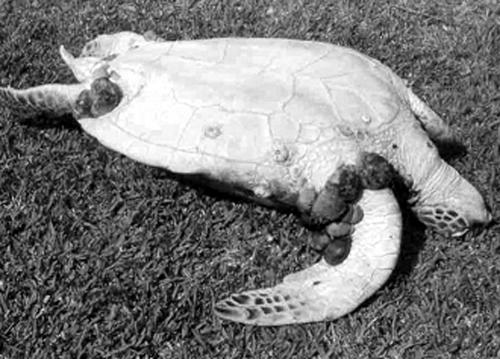Greenblatt et al. (4) discussed when fibropapilloma (FP)-associated turtle herpesvirus (FPTHV) became established in Hawaiian populations of sea turtles without citing the earliest records of FPs in Hawaiian sea turtles (11). However, this was rather significant to their discussion since the records occurred only 10 years (from 1947 to 1952) (Fig. 1) after the first report in the Atlantic (9, 10) (Florida Keys, 1937) and thus suggested that FP was worldwide and not introduced into the Pacific (11), as their genetic data also would suggest.
FIG. 1.
Fibropapilloma tumors in a green sea turtle (Chelonia mydas) collected from Waikiki, Hawaii, in 1952. Photograph by Charles E. Cutress.
Greenblatt et al. (4) stated that FP is only found in green (Chelonia mydas), loggerhead (Caretta caretta), and olive Ridley (Lepidochelys olivacea) sea turtles. While these may be the most commonly infected species, FP has been found in all sea turtle species (hawksbill sea turtles [Eretomochelys imbricata] [3, 11], even in Hawaii [11]; flatback sea turtles [Natator depressus] [7]; Kemp's Ridley sea turtles [L. kempii] [1, 6]; leatherback sea turtles [Dermochelys coriacea] [8]; and their hybrids [loggerhead × green sea turtles and loggerhead × hawksbill sea turtles]).
Greenblatt et al. (4) discussed the recent worldwide increase in cases of FP without citing the paper that presented cases throughout the Caribbean and first suggested this was a worldwide panzootic (12). They also omitted the later review of FP (7).
Unlike most leeches, which must leave the host to reproduce, Ozobranchus branchiatus and O. margoi can complete their complete reproductive cycle on the turtle hosts. Thus, they are not necessarily limited to coastal areas, as stated by Greenblatt et al. (4). Greenblatt et al. (5) somehow managed to publish an entire paper on these leeches without ever explaining exactly which species they were studying, nor they did state the species (Ozobranchus sp.) in reference 4. Both O. branchiatus and O. margoi occur on Hawaiian green sea turtles (2). It might be instructive in their rebuttal to explain which species of leech they analyzed.
Acknowledgments
We thank the late Charles E. Cutress, retired professor, Department of Marine Sciences, University of Puerto Rico, for the photograph and information on the Hawaiian FPs.
REFERENCES
- 1.Barragan, A. R., and L. Sarti. 1994. A possible case of fibropapilloma in Kemp's Ridley turtle (Lepidochelys kempii). Mar. Turtle Newsl. 67:27. [Google Scholar]
- 2.Choy, B. K., G. H. Balazs, and M. Dailey. 1989. A new therapy for marine turtles parasitized by the piscicolid leech, Ozobranchus brachiatus. Herpetol. Rev. 20:89-90. [Google Scholar]
- 3.D'Amato, A. F., and M. Moraes-Neto. 2000. First documentation of fibropapillomas verified by histopathology in Eretmochelys imbricata. Mar. Turtle Newsl. 89:12-13. [Google Scholar]
- 4.Greenblatt, R. J., S. L. Quackenbush, R. N. Casey, J. Rovnak, G. H. Balazs, T. M. Work, J. W. Casey, and C. A. Sutton. 2005. Genomic variation of the fibropapilloma-associated marine turtle herpesvirus across seven geographic areas and three host species. J. Virol. 79:1125-1132. [DOI] [PMC free article] [PubMed] [Google Scholar]
- 5.Greenblatt, R. J., T. M. Work, G. H. Balazs, C. A. Sutton, R. N. Casey, and J. W. Casey. 2004. The Ozobranchus leech is a candidate mechanical vector for the fibropapilloma-associated turtle herpesvirus found latently infecting skin tumors on Hawaiian green turtles (Chelonia mydas). Virology 321:101-110. [DOI] [PubMed] [Google Scholar]
- 6.Guillen, L., and J. P. Villalobos. 2000. Papillomas in Kemp's Ridley turtles, p. 237. In H. Kalb and T. Wibbels (ed.), Proceedings of the 19th Annual Symposium on Sea Turtle Biology and Conservation. National Oceanic and Atmospheric Administration technical memorandum NMFS-SEFSC-443. U.S. Department of Commerce, Washington, D.C.
- 7.Herbst, L. H. 1994. Fibropapillomatosis of marine turtles. Annu. Rev. Fish Dis. 4:389-425. [Google Scholar]
- 8.Huerta, P., H. Pineda, A. Aguirre, T. Spraker, L. Sarti, and A. Barragán. 2002. First confirmed case of fibropapilloma in a leatherback turtle (Dermochelys coriacea), p. 193. In A. Mosier, A. Foley, and B. Brost (ed.), Proceedings of the 20th Annual Symposium on Sea Turtle Biology and Conservation. National Oceanic and Atmospheric Administration technical memorandum NMFS-SEFSC-477. U.S. Department of Commerce, Washington, D.C.
- 9.Lucke, B. 1938. Studies on tumors in cold-blooded vertebrates. Pap. Tortugas Lab. 32:92-94. [Google Scholar]
- 10.Smith, G. M., and C. W. Coates. 1938. Fibro-epithelial growths of the skin in large marine turtles, Chelonia mydas (Linnaeus). Zoologica 24:379-380. [Google Scholar]
- 11.Williams, E. H., Jr., and L. Bunkley-Williams. 1996. Fibropapillomas in Hawaiian sea turtles. Bishop Mus. Occas. Pap. 46:46-49. [Google Scholar]
- 12.Williams, E. H., Jr., L. Bunkley-Williams, E. C. Peters, B. Pinto-Rodríguez, R. Matos-Morales, A. A. Mignucci-Giannoni, K. V. Hall, J. V. Rueda-Almonacid, J. Sybesma, I. Bonnelly de Calventi, and R. H. Boulon. 1994. An epizootic of cutaneous fibropapillomas in green turtles, Chelonia mydas of the Caribbean: part of a panzootic? J. Aquat. Anim. Health 6:70-78. [Google Scholar]



